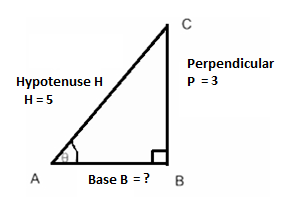Question
Question: Calculate: \(\sin \left( {2\arcsin \dfrac{3}{5}} \right)\)...
Calculate: sin(2arcsin53)
Solution
To proceed with the solution first we will find out the sin value by using pythagoras theorem later we will use the properties of Inverse Trigonometric Functions to find the value of the given expression.
Complete step-by-step solution:
According to the question. We have to find the value of sin(2arcsin53)
Now, to find the value of sin(2arcsin53)
Let us assume that arcsin53=θ
Then, 53=sinθ
Or, sinθ=53....................(i)
Now let us consider a right angledΔABC, right angled at B.

So, we know sinθ=hypotenuseperpendicular....................(ii)
So, comparing (i) and (ii) we get:
53=hypotenuseperpendicular
That is, Perpendicular = 3 and Hypotenuse = 5.
Using Pythagoras Theorem:
(hypotenuse)2=(base)2+(perpendicular)2 ⇒(5)2=(base)2+(3)2 ⇒25−9=(base)2 ⇒(base)2=16 ⇒(base)=16 ⇒base=±4
Now, to find the value of sin(2arcsin53)
Putting arcsin53=θin sin(2arcsin53)
It will now become as sin(2θ)
Now using the trigonometric formula for expanding sin(2θ):
sin(2θ)=2sinθcosθ
So, using the values of the Right angledΔABC,
We will get cosθ=hypotenusebase
So base=4 and hypotenuse = 5, putting these values we get
cosθ=54,
So with sinθ=53 and cosθ=54, the expression will now become:
sin(2θ)=2sinθcosθ =2×53×54 =2524
Hence, the value of sin(2arcsin53) is 2524.
Note: While using the expansion for a trigonometric multiple angle likesin(2θ), careful observation has to be made, if the trigonometric function taken is incorrect then the expansion will change and so will the corresponding solution. The expansion of trigonometric ratio is to be used depending on the trigonometric ratio mentioned in the term outside the arc trigonometric ratio. For example, instead of sin in sin(2arcsin53), if we have cos that is, cos(2arcsin53), then we will use the expansion of cos(2θ),which is given as cos2θ−sin2θ or 2cos2θ−1 or1−2sin2θ .
